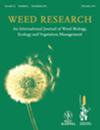降低生产性草地上出现鲁梅克斯(Rumex obtusifolius)风险的主要管理方法
IF 2.4
3区 农林科学
Q2 AGRONOMY
引用次数: 0
摘要
阔叶木贼(Rumex obtusifolius)是一种问题杂草,会降低全球温带地区草地的产量和饲草的营养价值。我们在农场开展了一项研究,以确定影响用于饲草生产的永久性高产草地上高密度出现钝叶杜父花的风险的管理方法和环境因素。瑞士、斯洛文尼亚和英国采用统一的方案,采用配对病例对照设计,比较高密度出现钝叶蜂(病例,≥1 株 m-2)的地块与附近没有或极低密度出现钝叶蜂的地块(对照,≤4 株 100 m-2)。在 CH、SI 和 UK 分别记录了 40 对、20 对和 18 对。测量的参数包括管理方法和历史数据、植被覆盖度和组成以及土壤养分和质地。在所有国家中,植被覆盖度的增加降低了赤潮发生的相对风险。相比之下,土壤中磷和钾含量的增加以及土壤容重的增加则会提高相对风险。这些影响在不同国家之间是一致的,因为没有观察到国家与任何因素之间的相互作用。案例地块的两个指示物种--大车前草和年铵苋--是受干扰地区和肥沃土壤的典型物种,而对照地块的指示物种则是中高管理强度下草地的特征物种(如红马齿苋、十字花科马齿苋、臭椿)。我们得出的结论是,草地遭受草翅葉蟬(R. obtusifolius)侵染的风险会受到管理措施的显著影响。预防措施应根据牧草植物的需要施磷、钾肥,尽量减少土壤板结,并保持草丛茂密。本文章由计算机程序翻译,如有差异,请以英文原文为准。
Key management practices to reduce the risk of the occurrence of Rumex obtusifolius in productive grasslands
Rumex obtusifolius (broad‐leaved dock) is a problematic weed that reduces yield and nutritional value of forage in grasslands of temperate regions worldwide. We conducted an on‐farm study to identify management practices and environmental factors that influence the risk of the occurrence of R. obtusifolius in high densities in permanent, productive grasslands used for forage production. Following a common protocol, a paired case–control design was implemented in Switzerland (CH), Slovenia (SI), and United Kingdom (UK) to compare parcels with high densities of R. obtusifolius (cases, ≥1 plant m−2) with nearby parcels free of or with very low densities of the species (controls, ≤4 plants 100 m−2). A total of 40, 20, and 18 pairs were recorded in CH, SI, and UK respectively. Parameters measured included data about management practices and history, vegetation cover and composition, and soil nutrients and texture. Across countries, increased vegetation cover reduced the relative risk of R. obtusifolius occurrence. By contrast, increased soil phosphorus and potassium and high soil bulk density raised the relative risk. These effects were consistent across countries, as no interactions between country and any of the factors were observed. The two indicator species for case parcels, Plantago major and Poa annua, were typical species of disturbed areas and fertile soils, while indicators for control parcels were characteristic of grasslands under medium to high management intensity (e.g., Festuca rubra, Cynosorus cristatus, Anthoxantum odoratum). We conclude that the risk for grassland infestation with R. obtusifolius can be significantly affected by management practices. Prevention measures should target phosphorus and potassium fertilisation to the forage plants' requirements, minimise soil compaction, and maintain dense swards.
求助全文
通过发布文献求助,成功后即可免费获取论文全文。
去求助
来源期刊

Weed Research
农林科学-农艺学
CiteScore
4.30
自引率
0.00%
发文量
41
审稿时长
12-24 weeks
期刊介绍:
Weed Research is an international peer-reviewed journal that publishes topical and innovative papers on weed science, in the English language. Its aim is to publish the best weed science from around the globe and to be the journal of choice for weed science researchers. It is the official journal of the European Weed Research Society. Papers are taken on all aspects of weeds, defined as plants that impact adversely on economic, aesthetic or environmental aspects of any system. Topics include, amongst others, weed biology and control, herbicides, invasive plant species in all environments, population and spatial biology, modelling, genetics, biodiversity and parasitic plants. The journal welcomes submissions on work carried out in any part of the world.
 求助内容:
求助内容: 应助结果提醒方式:
应助结果提醒方式:


